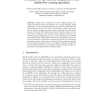Free Online Productivity Tools
i2Speak
i2Symbol
i2OCR
iTex2Img
iWeb2Print
iWeb2Shot
i2Type
iPdf2Split
iPdf2Merge
i2Bopomofo
i2Arabic
i2Style
i2Image
i2PDF
iLatex2Rtf
Sci2ools
108
Voted
ANTSW
2006
Springer
2006
Springer
An Analysis of the Different Components of the AntHocNet Routing Algorithm
Abstract. Mobile ad hoc networks are a class of highly dynamic networks. In previous work, we developed a new routing algorithm, called AntHocNet, for these challenging network environments. AntHocNet has been designed after the Ant Colony Optimization (ACO) framework, and its general architecture shares strong similarities with the architectures of typical ACO implementations for network routing. On the other hand, AntHocNet also contains several elements which are new to ACO routing implementations, such as the combination of ant-based path sampling with a lightweight information bootstrapping process, the use of both reactive and proactive components, and the use of composite pheromone metrics. In this paper we discuss all these elements, pointing out their general usefulness to face the multiple challenges of mobile ad hoc networks, and perform an evaluation of their working and effect on performance through extensive simulation studies.
ANTSW 2006 | Artificial Intelligence | Challenging Network Environments | Mobile Ad Hoc Networks | Typical Aco Implementations |
Related Content
| Added | 20 Aug 2010 |
| Updated | 20 Aug 2010 |
| Type | Conference |
| Year | 2006 |
| Where | ANTSW |
| Authors | Frederick Ducatelle, Gianni Di Caro, Luca Maria Gambardella |
Comments (0)

